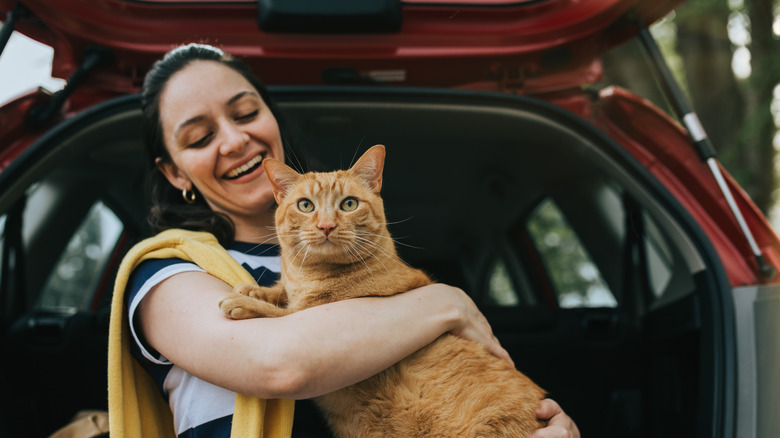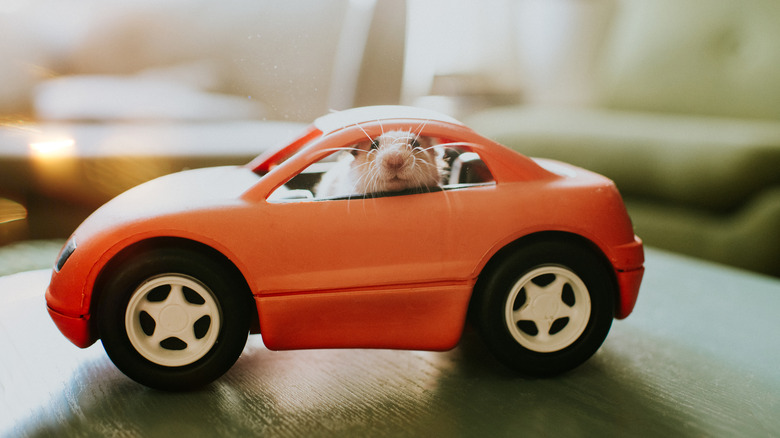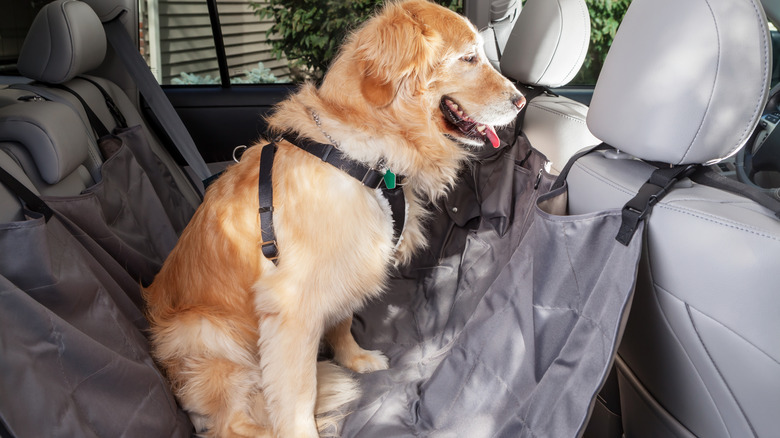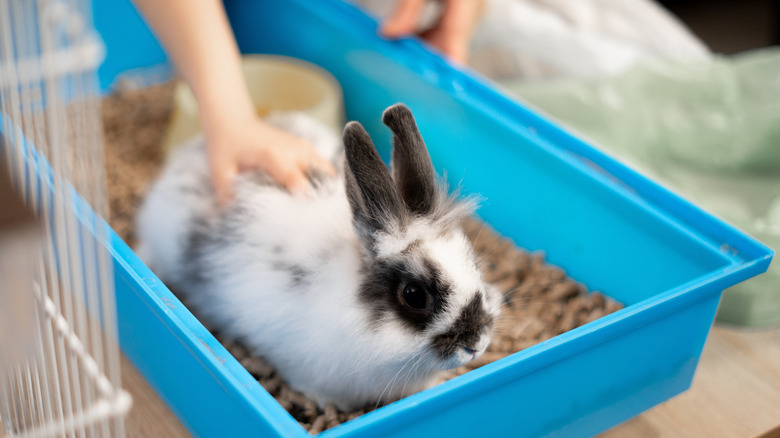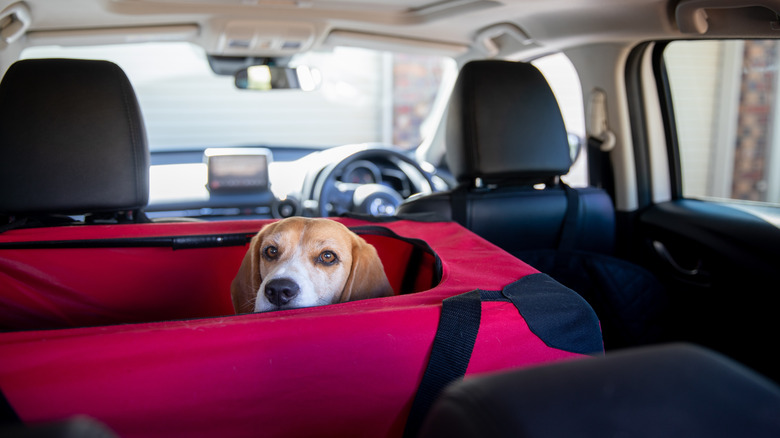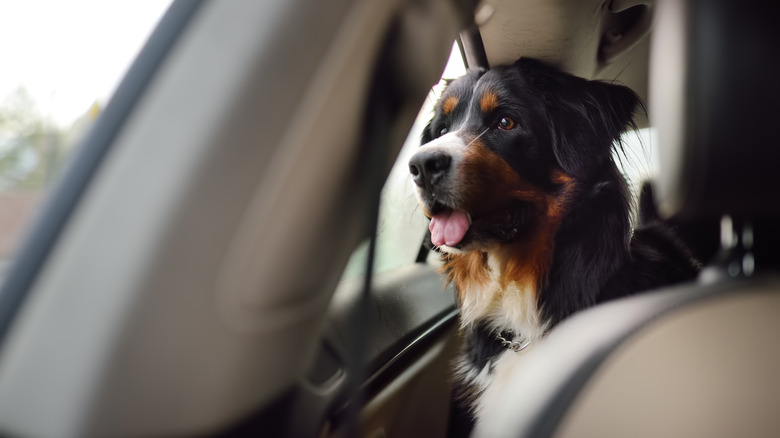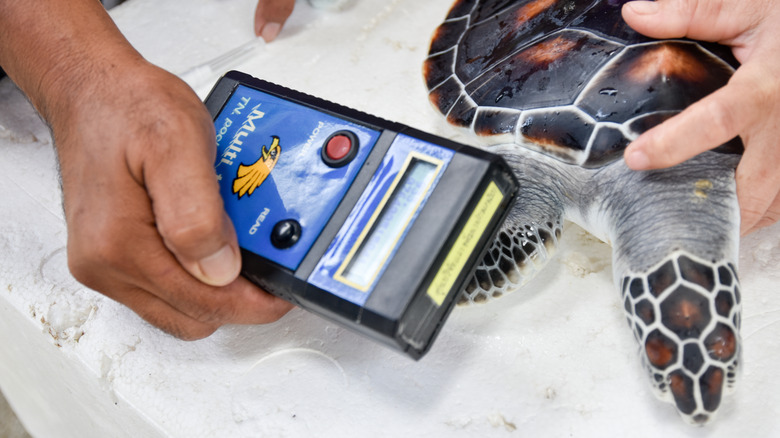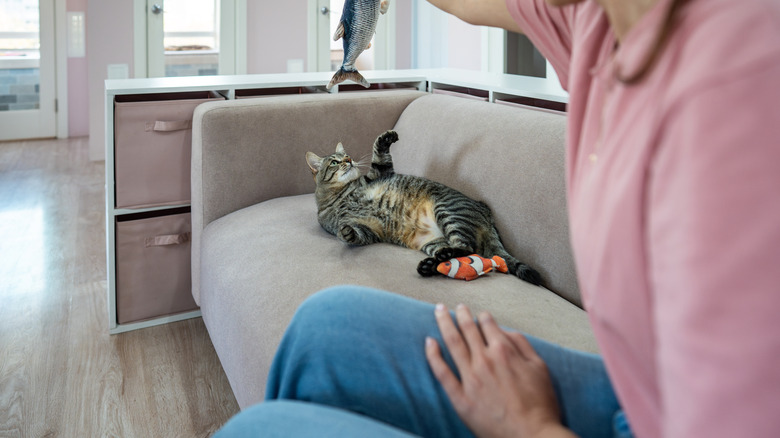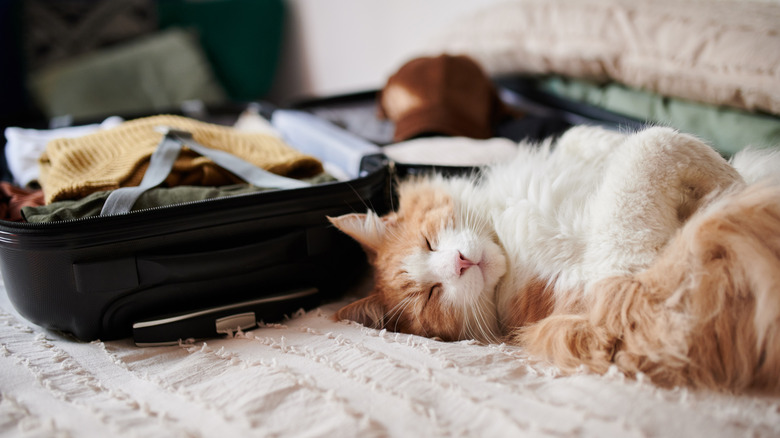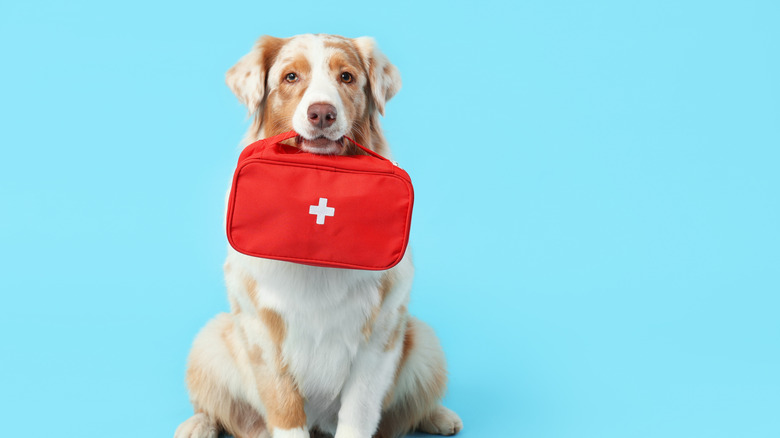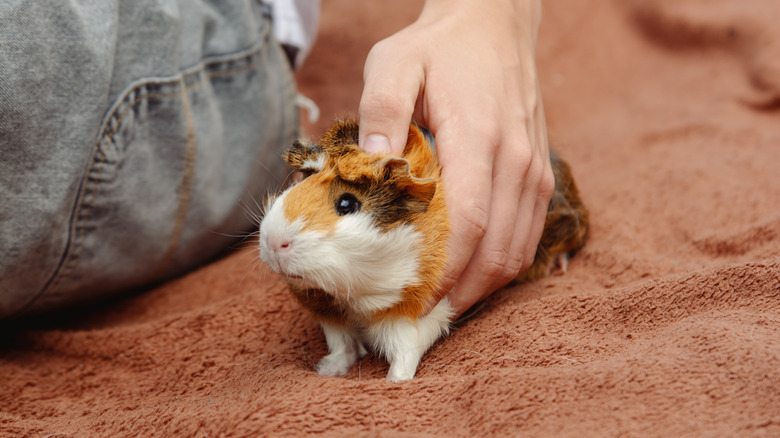The Most Game-Changing Tips For A Successful Road Trip With Your Pet, According To Research
Hitting the open road with your pet comes with unique challenges. For example, many pets suffer from common issues like motion sickness or travel anxiety. In addition, choosing where to stay can become a painstaking process of weeding through the fine print of pet policies, which is one of the most common mistakes people make when traveling with their pets. Before you even begin planning and prepping, it's worth reflecting on your goals and options.
Ask yourself some key questions: What kinds of challenges will such a journey create for your pet? If they struggle, how will you provide the extra attention, breaks, and comfort they'll need? And how might that level of responsibility affect your own ability to relax and enjoy the journey?
There are ways to traveling with your pet a breeze. Whether you're hitting the road with a cat, dog, hamster, lizard, or some other critter, a little preparation will go a long way. We've done some ground work to find the hacks that make all the difference, with a focus on how you can best plan for safety and comfort.
Choose your pet's seat
Safety first. To get started, choose the most strategic spot in your car where your pet will be safe and comfortable. They'll be spending a long stretch of time there, so it's worth some serious consideration. Imagine your pet in that space — will they want to look (or climb) out the window or crawl down underneath the front seat? Start to anticipate their experience.
Generally speaking, it's safest to place pets in the back seat of a car, or in the cargo area of an SUV. Keeping them in the rear helps prevent distractions that could occur if your pet tries to climb into your lap, block your view, or interfere with the steering wheel or gear shift. Even the most well-behaved pets can become restless during long drives and may want to make contact with you.
In addition, most car safety gear for pets is designed with backseat installation in mind. This setup helps keep the restraint anchored during sudden stops. Beyond safety, the back seat can also be more comfortable for your pet. It gives them more room to stretch out, and a quieter ride away from the busy dashboard and windshield.
Invest in safety gear
Finding the right gear can upgrade you and your pet's sense of safety on the road from a stressful juggling act into hands-free joy. The goal is to secure your pet inside the car to protect them in the event of sudden stops, and prevent them from distracting the driver. Experts recommend seeking out safety products that have been independently certified. For example, the Center for Pet Safety offers such certification based on independent product testing.
For dogs, options range from seatbelt-compatible harnesses to booster seats. Larger dogs might be more comfortable in a crate secured in the cargo area of an SUV. Cats, on the other hand, typically feel more secure in a sturdy carrier, which should be belted into place to minimize jostling.
Tools like barriers, hammocks, or seat protectors can help keep pets in place, reduce sliding, and provide a more defined space for them to rest. For small pets like rabbits, guinea pigs, hamsters, or reptiles, a cage is usually best. Just be sure to remove any heavy or loose objects such as wooden toys, water bottles, or rocks since they could shift and cause injury if the car changes speed or direction.
Break in new gear
Pets can be sensitive to unfamiliar items. By gradually introducing new gear, you'll help ease their adjustment and reduce the chances of stress when it's finally time to hit the road. This will make a huge difference and save you time trying to ease your pet's worries on the road.
Start introducing them to new gear well before your trip. Familiarize them with one object at a time, especially with essentials like a new carrier, crate, or harness. Place the item in their usual environment, whether it be on the living room floor, near their bed, or wherever they tend to spend a lot of time. Allow them to see, smell, and explore it at their own pace.
Encourage curiosity by rewarding small interactions, such as sniffing the harness or stepping inside the carrier, with gentle praise or treats. This positive reinforcement helps them form an association between the gear and a sense of safety or comfort. For pets that are especially cautious, placing a favorite toy, food, or even a piece of your clothing with your scent inside a carrier can create a sense of reassurance.
Practice short trips
This is absolutely critical. If it's your pet's first time in a car or on a longer trip, do some ground work way ahead of time. The goal is both to help your pet become accustomed to the car, as well as help you become aware of when your pet becomes excited, anxious, fatigued, etc. Learn their limits as well as what brings them joy.
Start by letting them explore the car while it's parked, followed by doing a few short practice rounds. Take a ride around the block. If this goes well, move on to a longer route–say a few hours away, or a full day trip. Take notes on how your pet reacts in different circumstances such as heavy honking traffic, driving on a highway at higher speeds, with music playing, on a bumpy or curvy road, etc. As you did with breaking in new gear, offer positive reinforcement.
This will help your pet associate the car with positive, low-stress experiences. It also gives you the chance to develop a solid picture of the challenges and opportunities you'll face. Make adjustments to your car setup and packing list accordingly, ahead of setting out on your big adventure together.
Additional car considerations
As you and your pet gain the knowledge and confidence that comes with practice, there are other game-changing details to consider. For example, the image of a dog sticking its head out the window is classic. However, research shows that having windows down exposes pets to serious hazards. Allowing some air circulation is fine, but be careful not to put your pet in danger by rolling them down all the way.
Equally important is one of the biggest non-negotiable rules of car travel with pets: Never leave them unattended in a parked car. On a summer day, even with the windows cracked, temperatures inside a vehicle can soar within minutes to levels that can cause heatstroke or worse. The winter can be just as dangerous because freezing conditions can put your pet at risk of hypothermia or frostbite. This is especially important when traveling with reptiles, since cold-blooded animals are extremely sensitive to the temperature in their environment.
Planning ahead is key: Check the forecast along your route, and pack any extra gear your animal might need for comfort in extreme weather, such as cooling mats, portable fans, or warm blankets.
Update tags and/or microchip
If your pet gets lost, you want to be prepared to take action and increase the likelihood and speed with which you're able to find them in unfamiliar surroundings. Ensuring your pet's tags and/or microchip are up to date will help.
Most people put the pet's name and a cell phone number on their tags. If your contact info has changed, you'll need to get new tags. To update a pet's microchip information, you must contact the company associated with the microchip and provide your new information. While many popular providers offer free, unlimited updates online or by phone at any time of day, it can take some time for the changes to appear in the registry. Thus, it's an important step to take well before you go on your trip.
Almost all vet clinics have scanners for pet microchips. When scanned, a microchip reads out a unique, permanent ID number associated with your pet. Using that number, the vet can contact the microchip registry and receive the contact information you provided. Remember, microchips are as small as a grain of rice and aren't just for cats and dogs — they can be used on various kinds of pets including many reptiles, rodents, and birds.
Locate vets along your route
In the same vein, think about what you would do if your pet becomes ill or injured during your trip. As you choose your destinations and map out your routes, set aside some time to research local vets and emergency clinics. You may especially want to look for pet hospitals with good reviews that are open 24/7 and within a one-hour drive or less from where you're staying. You can even call ahead and ask questions about what kinds of services they offer, especially if your pet has a known condition that may need attention.
It may also be a good time to refresh yourself on common signs of illness or injury in your pet that require immediate medical attention. This can include things like difficulty breathing, bleeding that doesn't stop after five minutes, or signs of extreme pain or anxiety. For non-emergency situations, make sure you have your vet's contact information and hours of service easily accessible should you need to call them while you're on the road. This is a good time to also make sure your pet insurance plan fits your needs while traveling, and that coverage includes unexpected injuries and vets in the area where you're going.
Plan for breaks
Having a non-human companion in the car often means making more frequent stops for food, water, bathrooms, and stretching. This means it will likely take longer to get to your destination than it would otherwise. For example, a trip from New York City to Raleigh, North Carolina can be done in a single day — basically less than 10 hours with minimal stops. However, if you're taking minimum 20-minute bio breaks for your pup every two to three hours (which is recommended), you may need to break up the trip into two days.
It's dangerous to you, your pet, and other drivers to try and feed them on the road. Ideally, you'll want to do a bit of research to find quiet, shaded, and grassy stops, like one of Idaho's most unique roadside attractions that's a dog lover's paradise. Across the U.S., there's Love's truck stop chain, which offers more than 400 locations with 24-hour, fully fenced dog parks. However, rest areas next to highways are often quite noisy and lack shade. The Sniffspot platform allows dog owners to search for nearby private parks to rent for their pups. Although it may add a bit more prep and travel time, it's worth seeking out stops that are truly tranquil and restorative for you and your furry friend.
Find pet-friendly accomodations
Pet-friendly rooms at hotels are often limited and can fill up quickly, especially during peak travel seasons. Don't assume that all locations of a hotel chain follow the same rules as policies can vary widely by property. The same applies for accommodations like Airbnb. Call ahead and confirm the details of the pet policy before you arrive.
Several well-known hotel chains have pet-friendly policies, making them a good starting point for your search. For example, La Quinta, Choice Hotels, Red Roof Inn, and Best Western are recognized for accommodating travelers with pets. Sometimes there's an additional pet fee. It's important to review restrictions on weight, the number of animals allowed per room, and whether certain types of pets are accepted.
If you're traveling with a less common pet such as a rabbit, guinea pig, or hamster, you'll want to be even more proactive. While cats and dogs are generally accounted for in most policies, smaller animals may not be. In those cases, vacation rentals through platforms like Airbnb or Vrbo may offer more flexibility to negotiate with a host.
Check in with the vet
Traveling often means exposure to new environments, other animals, and potential health risks. Making a visit to the vet about 10 days before your departure is the best way to tackle these challenges head-on. Make sure your companion is up to date on all required vaccines and routine care. If you're crossing state lines or international borders, you may also need to consider traveling with a pet passport, as well as getting specific vaccinations and health certificates.
This appointment is also a great opportunity to talk through any health or behavior concerns related to travel. Many pets experience anxiety in new environments or when confined in a moving vehicle. Prepare some questions for the vet in advance based on your plans.
For example, does your pet need flea and tick prevention if you're heading to a wooded area? Would a mild sedative be appropriate for a highly anxious animal on a long car ride? How should you handle hydration, especially if you'll be in hot climates? Your vet can tailor their advice to your pet's individual needs and the specifics of your journey.
Pack essentials in advance
Packing a few days in advance will save you a lot of last-minute stress. This extra time gives you a cushion in case you realize you're running low on something essential, like poop bags, medicine, or your pet's specific brand of food. While it's tempting to assume you can pick things up along the way, keep in mind that grocery stores in smaller towns don't always carry the brands or specialized items your pet is used to.
Start with the basics: food, water, medicine, feeding bowls, and waste disposal items. Then think a step further. Pack some treats, an extra leash in case one breaks, a favorite toy and blanket. Finally, don't forget paperwork. Having copies of your pet's medical records on hand can make a huge difference if you need to visit a vet during your travels. Thoughtful packing makes for a smoother, safer journey.
Go beyond essentials
It's often the less obvious items that are the real life-savers once you're on the road. Packing a few thoughtful extras can save you from stressful moments and make your pet's trip a lot more comfortable.
For example, you may not think of packing a pet-specific first aid kit, but it can be a lifesaver. Tweezers for ticks or splinters, paw balm for cracked pads, and styptic powder for minor bleeding are things you don't want to be without. Stain and odor remover wipes are another unsung hero. Even with all the car prep mentioned above, accidents are bound to happen. Having tools on hand makes it easy to clean up accidents in cars or hotels without leaving a trace.
Don't forget about comfort, either. For example, a small battery-powered fan is indispensable for hot days in the car. A clip-on LED light for nighttime potty breaks can make your life so much easier. If you're traveling with cats or small animals, disposable litter boxes or potty pads are imminently clutch.
24 hours before your trip
Give your pet plenty of exercise, including long walks for dogs, extended play sessions for cats, and enrichment time for small animals. The goal is to help them burn off extra energy so they're calmer and more relaxed once the car ride begins. And of course, make sure they've relieved themselves before departure to minimize the chance of accidents.
When it comes to meals, timing and portion size matter. Feeding your pet a light meal a few hours before departure helps reduce the risk of motion sickness, which can be triggered by a full stomach in a moving vehicle. Save larger meals for when you've stopped for the day. Keep treats on hand for positive reinforcement to get the trip off on the right foot.
It also helps to give your pet a little quiet time before loading up. Some animals pick up on the energy of packing and may become anxious if everything feels rushed. Offering calm reassurance, keeping to their usual routine as much as possible, and allowing them to settle before the trip can make a big difference in how smoothly the journey begins.
Methodology
While preparing this list of tips, we drew on a wide range of resources created by animal care experts, veterinarians, and experienced pet owners. Our goal was to ensure that the advice presented here is backed by expert knowledge and experience. We also focused on advice that helped improve the safety and comfort of both pets and their owners during road trips.
We reviewed guidance from leading pet advocacy organizations such as the Animal Humane Society and the SPCA, both of which publish detailed resources on traveling safely with pets. Veterinary sources, including PetMD and blogs of local clinics, provided additional insight into common health concerns like motion sickness and anxiety, as well as strategies for prevention and treatment.
We also incorporated travel blogs and forums written by pet owners who have logged thousands of miles with their dogs, cats, hamsters, and reptiles. Together, these sources provided a balanced foundation for a comprehensive guide to hitting the road with pets safely and comfortably.
